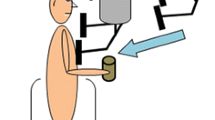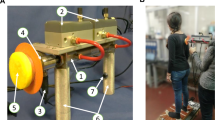Abstract
The aim of the present study was to investigate the relationship between proactive and reactive components of postural control. We contrasted the kinematic and electromyographic (EMG) responses to multidirectional voluntary leg lifts with those elicited by unexpected surface tilts. In particular, we addressed the role of trunk stabilization following either a voluntary or forced weight shift from double to single limb support. Nine young female subjects stood with a standing posture of 45° toe-out and their arms abducted to shoulder level. On the experimenter’s signal, subjects either (1) lifted one leg as fast as possible in one of six directions (R/L side, R/L diagonal front, R/L diagonal back) to a height of 45° or (2) maintained standing as the support surface tilted at a rate of 53°/s to a height of 10° in one of six directions (R/L-up, R/L diagonal toes-up, R/L diagonal toes-down). For both tasks, our results showed that the center of pressure (COP) displacement began before or in conjunction with displacement of the center of mass (COM), after which the COP oscillated about the horizontal projection of the COM. In addition, the muscles were recruited in a distal-to-proximal sequence, either in anticipation of the voluntary leg lift or in response to the sudden surface tilt. Thus, the COP was being used dynamically to control displacement of the COM. The axial postural strategy comprising head, trunk, and pelvis movements was quantified by means of principal component analysis. More than 95% of the variance in the data could be described by the first two eigenvectors, which revealed specific coordination patterns dominated by pelvis rotation in one direction and head/trunk rotation in the opposite direction. Unexpected surface tilting elicited an automatic response strategy that focused on controlling the orientation of the head and trunk with respect to the vertical gravity vector while trunk verticality was compromised for movement generation and the recovery of postural equilibrium during leg lifting. In conclusion, regardless of the type (voluntary versus involuntary) or direction of perturbation, the strategy employed by the central nervous system to control the body COM displacement concerns mainly trunk stabilization.







Similar content being viewed by others
References
Allum JH, Honegger F (1998) Interactions between vestibular and proprioceptive inputs triggering and modulating human balance-correcting responses differ across muscles. Exp Brain Res 121:478–494
Allum JH, Gresty M, Keshner E, Shupert C (1997) The control of head movements during human balance corrections. J Vestib Res 7:189–218
Andersen RA, Snyder LH, Li CS, Stricanne B (1993) Coordinate transformations in the representation of spatial information. Curr Opin Neurobiol 3:171–176
Assaiante C, Amblard B (1993) Ontogenesis of head stabilization in space during locomotion in children: influence of visual cues. Exp Brain Res 93:499–515
Assiante C, McKinley PA, Amblard B (1997) Head-trunk coordination during hops using one or two feet in children and adults. J Vestib Res 7:145–160
Baroni G, Ferrigno G, Rabuffetti M, Pedotti A, Massion J (1999) Long-term adaptation of postural control in microgravity. Exp Brain Res 128:410–416
Bianchi L, Angelini D, Orani GP, Lacquaniti F (1998) Kinematic coordination in human gait: relation to mechanical energy cost. J Neurophysiol 79:2155–2170
Borghese NA, Bianchi L, Lacquaniti F (1996) Kinematic determinants of human locomotion. J Physiol 494:863–879
Clement G, Pozzo T, Berthoz A (1988) Contribution of eye positioning to control of the upside-down standing posture. Exp Brain Res 73:569–576
Diener H-C, Dichgans J (1988) On the role of vestibular, visual and somatosensory information for dynamic postural control in humans. Prog Brain Res 76:253–262
Do MC, Nouillot P, Bouisset S (1991) Is balance or posture at the end of a voluntary movement programmed? Neurosci Lett 130:9–11
Fung J, Johnstone E (1998) Lost in space: multi-axial and multi-dimensional surface perturbations delivered by a novel motion base device. Soc Neurosci Abs 24:1158
Grasso R, Zago M, Lacquaniti F (2000) Interactions between posture and locomotion: motor patterns in humans walking with bent posture versus erect posture. J Neurophysiol 83:288–300
Henry SM, Fung J, Horak F (1998) Control of stance during lateral and anterior/posterior surface translations. IEEE Trans Rehab Eng 6:32–42
Hlavacka F, Mergner T, Krizkova M (1996) Control of the body vertical by vestibular and proprioceptive inputs. Brain Res Bull 40:431–434
Hodges P, Cresswell A, Thortensson A (1999) Preparatory trunk motion accompanies rapid upper limb movement. Exp Brain Res 124:69–79
Kaminski TR, Simpkins S (2001) The effects of stance configuration and target distance on reaching I. Movement preparation. Exp Brain Res 136:439–446
Kavounoudias A, Roll R, Roll J-P (1998) The plantar sole is a “dynamometric map” for human balance control. Neuroreport 9:3247–3252
Kavounoudias A, Roll R, Roll J-P (2001) Foot sole and ankle muscle inputs contribute jointly to human erect posture regulation. J Physiol 532:869–878
Lyon IN, Day B (1997) Control of frontal plane body motion in human stepping. Exp Brain Res 115:488–507
Macpherson JM (1994) The force constraint strategy for stance is independent of prior experience. Exp Brain Res 101:397–405
Massion J (1992) Movement, posture and equilibrium: interaction and coordination. Prog Neurobiol 38:35–56
Massion J, Fabre JC, Mouchnino L, Obadia A (1995) Body orientation and regulation of the center of gravity during movement under water. J Vestib Res 5:211–221
Massion J, Popov K, Fabre JC, Rage P, Gurfinkel V (1997) Is the erect posture in microgravity based on control of trunk orientation or center of mass position? Exp Brain Res 114:384–389
Mauer C, Mergner T, Bolha B, Hlavacka F (2000) Vestibular, visual, and somatosensory contributions to human control of upright stance. Neurosci Lett 281:99–102
McIlroy WE, Bent LR, Potvin JR, Brooke JD, Maki BE (1999) Preparatory balance adjustments precede withdrawal response to noxious stimulation in standing humans. Neurosci Lett 267:197–200
Mergner T, Siebold C, Schweigart G, Becker W (1991) Human perception of horizontal trunk and head rotation in space during vestibular and neck stimulation. Exp Brain Res 85:389–404
Mergner T, Hlavacka F, Schweigart G (1993) Interaction of vestibular and proprioceptive inputs. J Vestib Res 3:41–57
Merkle LA, Layne CS, Bloomberg JJ, Zhang JJ (1998) Using factor analysis to identify neuromuscular synergies during treadmill walking. J Neurosci Methods 82:207–214
Mille ML, Mouchnino L (1998) Are human anticipatory postural adjustments affected by a modification of the initial position of the center of gravity? Neurosci Lett 242:61–64
Mouchnino L, Aurenty R, Massion J, Pedotti A (1992) Coordination between equilibrium and head-trunk orientation during leg movement: a new strategy built up by training. J Neurophysiol 67:1587–1598
Mouchnino L, Aurenty R, Massion J, Pedotti A (1993) Is the trunk a reference frame for calculating leg position? Neuroreport 4:125–127
Mouchnino L, Cincera M, Fabre JC, Assaiante C, Amblard B, Pedotti A, Massion J (1996) Is the regulation of the center of mass maintained during leg movement under microgravity conditions? J Neurophysiol 76:1212–1223
Nashner LM, Shupert CL, Horak FB (1988) Head-trunk movement coordination in the standing posture. Prog Brain Res 76:243–251
Pozzo T, Berthoz A, Lefort L (1990) Head stabilization during various locomotor tasks in humans. I. Normal subjects. Exp Brain Res 82:97–106
Pozzo T, Levik Y, Berthoz A (1992) Head stabilization in the frontal plane during complex equilibrium tasks in humans. In: Woollacott M, Horak F (eds) Posture and gait: control mechanisms. University of Oregon Books, Eugene OR, pp 118–121
Pozzo T, Levik Y, Berthoz A (1995) Head and trunk movements in the frontal plane during complex dynamic equilibrium tasks in humans. Exp Brain Res 106:327–338
Preuss R, Fung J (2004) A simple method to estimate force plate inertial components in a moving surface. J Biomech 37:1177-1180
Rogers MW, Pai YC (1990) Dynamic transitions in stance support accompanying leg flexion movements in man. Exp Brain Res 81:398–402
Rogers MW, Pai YC (1995) Organization of preparatory postural responses for the initiation of lateral body motion during goal directed leg movements. Neurosci Lett 187:99–102
Roll R, Kavounoudias A, Roll J-P (2002) Cutaneous afferent from human plantar sole contribute to body posture awareness. Neuroreport 13:1957–1961
Winter DA (1990) Biomechanics and control of human movement, 2nd edn. Wiley, New York
Acknowledgements
We would like to thank Rumpa Boonsinsukh and Margerita Rapagna for their assistance with data collection, Dr. Patricia McKinley for her helpful suggestions with the manuscript, and Dr. David Burns for his invaluable contribution to the use of PCA. This study was supported by the Canada Foundation for Innovation, CRIR, and the JRH Foundation.
Author information
Authors and Affiliations
Corresponding author
Rights and permissions
About this article
Cite this article
Hughey, L.K., Fung, J. Postural responses triggered by multidirectional leg lifts and surface tilts. Exp Brain Res 165, 152–166 (2005). https://doi.org/10.1007/s00221-005-2295-9
Received:
Accepted:
Published:
Issue Date:
DOI: https://doi.org/10.1007/s00221-005-2295-9




